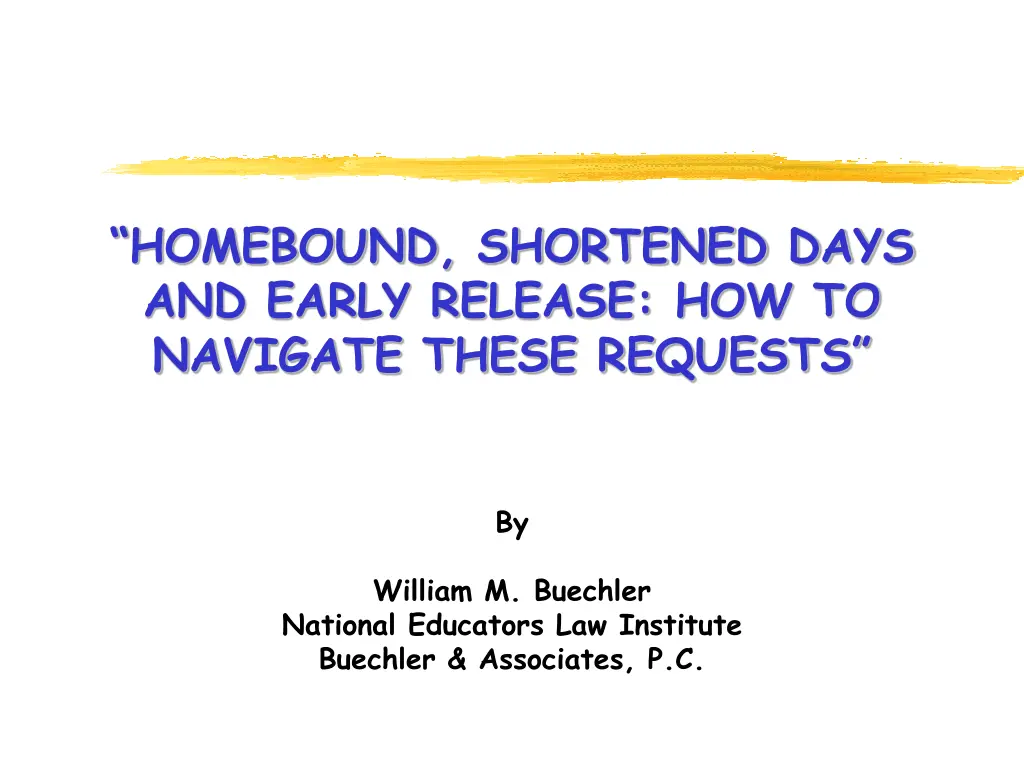
Navigating Homebound & Shortened School Days
Learn how to handle requests for homebound placements and shortened school days effectively under federal law, focusing on the concept of the Least Restrictive Environment (LRE) and the continuum of placements. Understand the considerations and regulations related to providing education for children with disabilities in inclusive settings.
Uploaded on | 0 Views
Download Presentation

Please find below an Image/Link to download the presentation.
The content on the website is provided AS IS for your information and personal use only. It may not be sold, licensed, or shared on other websites without obtaining consent from the author. If you encounter any issues during the download, it is possible that the publisher has removed the file from their server.
You are allowed to download the files provided on this website for personal or commercial use, subject to the condition that they are used lawfully. All files are the property of their respective owners.
The content on the website is provided AS IS for your information and personal use only. It may not be sold, licensed, or shared on other websites without obtaining consent from the author.
E N D
Presentation Transcript
HOMEBOUND, SHORTENED DAYS AND EARLY RELEASE: HOW TO NAVIGATE THESE REQUESTS By William M. Buechler National Educators Law Institute Buechler & Associates, P.C.
HOMEBOUND PLACEMENTS AND SHORTENED SCHOOL DAYS GENERAL CONCEPTS Both issues deal with the least restrictive environment concepts set forth in IDEA The IDEA continuum of placements presumes a placement in the least restrictive setting, unless the child needs a more restrictive setting to benefit from the program. School days should not be shortened, unless it is necessary for the child to receive FAPE.
How is the term the Least Restrictive Environment defined? The federal regulations define LRE as follows: To the maximum extent appropriate, children with disabilities, including children in public or private institutions or other care facilities, are educated with children who are nondisabled; and
Special classes, separate schooling, or other removal of children with disabilities from the regular educational environment occurs only if the nature or severity of the disability is such that education in regular classes with the use of supplementary aides and services cannot be achieved satisfactorily.
SCHOOLS ARE REQUIRED TO PROVIDE A CONTINUUM OF PLACEMENTS UNDER FEDERAL LAW 1. General education is the least restrictive 2. Residential placement is the most restrictive 3. Federal law does not dictate what placements need to be provided 4. Only requirement is that placements are appropriate
HOMEBOUND PLACEMENTS GENERAL CONSIDERATIONS Concerns with homebound placements: Arguably, the most restrictive placement Student has no interaction with non-disabled peers Ability to provide related services is limited Services cannot replicate program offered in regular environment HOMEBOUND SHOULD NOT BE USED AS A DISCIPLINARY ALTERNATIVE PLACEMENT
HOMEBOUND PLACEMENTS GENERAL CONSIDERATIONS (CON T) Homebound services may enable the student to continue to make progress in school during times when the student is unable to attend. Generally, a homebound setting is appropriate for students with medical conditions that render the child unable to safely attend school for more than 4 weeks.
GENRAL EDUCATION HOMEBOUND INSTRUCTION State mechanism in place for serving kids through general education homebound ( GEH ) instruction Procedures laid out in TEA s Student Attendance Accounting Handbook In policy EEH (Local)
SO, DO WE SERVE THE STUDENTS THROUGH GENERAL EDUCATION OR SPECIAL EDUCATION ? . . . Factors to consider: 1. Will general education suffice? 2. Is the student already in special education? 3. Does the child need special education? 4. Is the student chronically ill?
HOMEBOUND UNDER SPECIAL EDUCATION Requirements: Student is expected to be confined for a minimum of four consecutive weeks as documented by a physician Homebound may also be provided to chronically ill students who are expected to be confined for any period of time totaling at least four weeks throughout the school year, if documented by a physician ARD DETERMINES AMOUNT OF SERVICES
HOMEBOUND UNDER SPECIAL EDUCATION ELIGIBILITY Can be simple or complicated Issues arise over long term recommendations, or when dispute over appropriateness of school program Difficult to obtain second evaluations or second opinions since doctors may be reluctant to second guess medical opinion of treating physician
HOMEBOUND UNDER SPECIAL EDUCATION ELIGIBILITY Eligibility factors: May be through general or special ed, depending on instructional needs of student Should require consent for evaluation, including consent to obtain medical information from treating physician Consent should include ability to observe in home (to allow medical or nursing assessment)
IF A PARENT IS SEEKING A PLACEMENT THE REST OF THE COMMITTEE DOES NOT BELIEVE IS APPROPRIATE, WHAT SHOULD THE COMMITTEE DO? DO WHAT IS APPROPRIATE FOR THE CHILD. The law does not mandate that parental wishes be followed to the detriment of the child s education, and districts remain liable for the provision of FAPE.
WHAT ACTION SHOULD A DISTRICT TAKE WHEN A STUDENT IS MOVED TO A MORE RESTRICTIVE SETTING? Establish conditions that would warrant the student be integrated back into a less restrictive environment.
SHORTENED SCHOOL DAYS ISSUES Not to be used based on administrative convenience or district policy Must be tied to the individual needs of the student Provide a transition plan to return to school If day must be shortened, try to avoid academic times
SHORTENED SCHOOL DAYS FOR BEHAVIORAL ISSUES The issue of shortened school days based on behavioral issues has become a focus for advocates around the U.S. In March of 2019, a lawsuit was filed against the state of Oregon arguing that the state had failed to provide full school days for special needs students with behavioral problems. The concern has extended to other states, including Texas.
TEXAS LAW ON INSTRUCTIONAL DAY Under Texas law, students with disabilities must have available an instructional day commensurate with that of students without disabilities. The ARD committee must determine the appropriate instructional setting and length of day for each student, and these must be specified in the student s IEP. 19 T.A.C. Section 89.1075 (e)
SPRING BRANCH ISD v. O.W. (5th Cir. 2019) Recent Fifth Circuit case addressing, among other things, the student s shortened school day for behavioral issues. FACTS: O.W. was in fifth grade and eventually was determined to qualify as ED. After an incident involving the police, the parent and district agreed, through an ARD amendment, that the student s school day should begin at 9 rather than 7:30 am. Several days later, the parent and district agreed that his day should be shorted to three hours for the remainder of the year. An email stated that a brief ARD would be necessary, but that the shortened day could begin the next morning.
SPRING BRANCH ISD v. O.W. (5th Cir. 2019) DETERMINATION BY COURT: Under 34 C.F.R. Section 300.324 (a)(4), the IEP may be amended without an ARD when the parent and district 1) agree to the modification; 2) agree not to convene an IEP meeting; and 3) develop a written document to amend or modify the IEP. In this instance, the requirements were met for changing the start time to 9 am. However, the district failed to meet the requirements prior to reducing the student s day to 3 hours. No ARD was held and no written agreement was put into place prior to reducing the student s day.



